Anchor the marmot was surprisingly calm, considering a stranger had just swabbed his cheek. It was a cool, crisp evening in west-central Colorado, and the 11-month-old male yellow-bellied marmot had wandered into a metal cage trap. Now a couple of scientists sampled his DNA to measure how fast this fur ball was growing.
Since 1962, scientists in this high mountain meadow have been mapping marmots’ social lives. But lately researchers have also turned their attention to tracking how a warming planet is shifting nature’s schedule and, perhaps, affecting marmot health.
Each spring marmots rise from their winter slumber. They mate, give birth, and spend summers chowing down before they hibernate again. “It’s get fat or die,” Conner Philson, a Ph.D. candidate at UCLA, told me as he held Anchor in a dark Kevlar bag so the animal couldn’t slice a finger with his huge incisors. After she ran a square of foam through the marmot’s mouth for cell samples, Philson’s colleague, UCLA master’s student Mackenzie Scurka, used calipers to measure one tiny paw. Then Philson thanked his subject for not dousing us in feces. “It’s much nicer when they poop in the trap and not on us,” he said.
Marmots’ behavior is changing. Because of climate change, they now emerge from winter about a month earlier, which forces them to scrounge for food sooner. Yet most marmots, as researchers also would learn with Anchor, actually still wind up big and healthy. Early emergence gives them extra time to eat, which lets them get fatter and helps them produce more offspring.
Nature’s shifting calendar for marmots thus far seems to have been an asset. But that’s almost certainly the exception, not the norm.
Timing is everything in nature. From the opening notes of a songbird’s spring chorus to the seasonal percussion of snapping shrimp, every important ecological process lives and dies by a clock. Flowering. Egg laying. Breeding. Migration. It’s as true on the Mongolian steppe as it is in the Arabian Sea or a Costa Rican rainforest. Centuries of evolution honed these patterns. Now climate change is recalibrating them.
And that is reshaping life for almost everything. In every ocean and across every continent, seasons are in flux. Earlier warmth, delayed cold, and shifts in the frequency and fierceness of precipitation are toying with established rhythms in both predictable and unexpected ways.
So researchers the world over are straining to document the timing of life cycle events, a scientific discipline known as phenology. That timing is being upended by our fossil fuel emissions.
Change of pace
Across much of the United States rising average temperatures are pushing spring to speed up its arrival. Plants and pollinators found at high elevations in the western U.S. are especially affected. To better understand how species are interacting and responding to these changes, scientists are tracking the timing of biological events—a field known as phenology.


